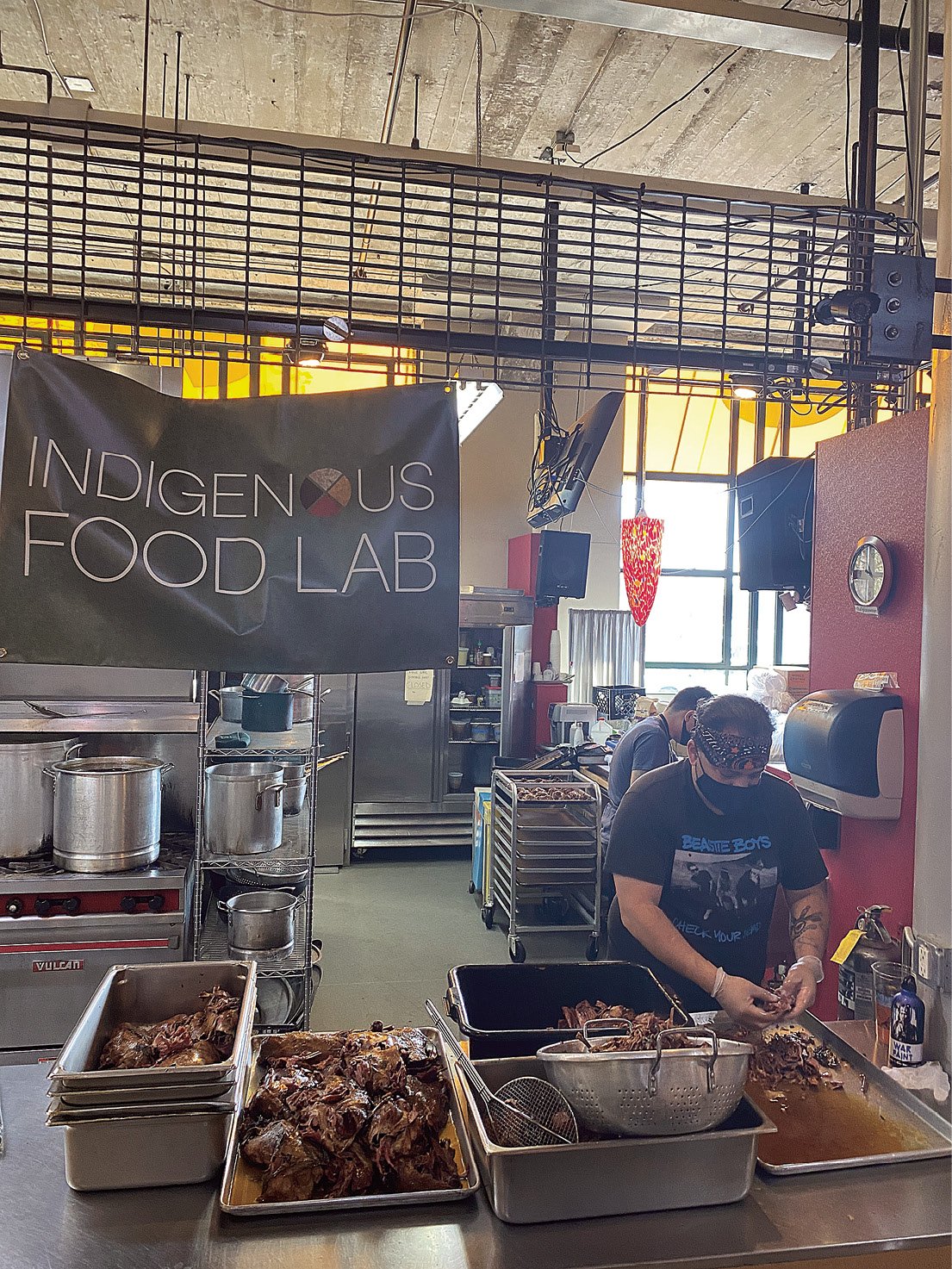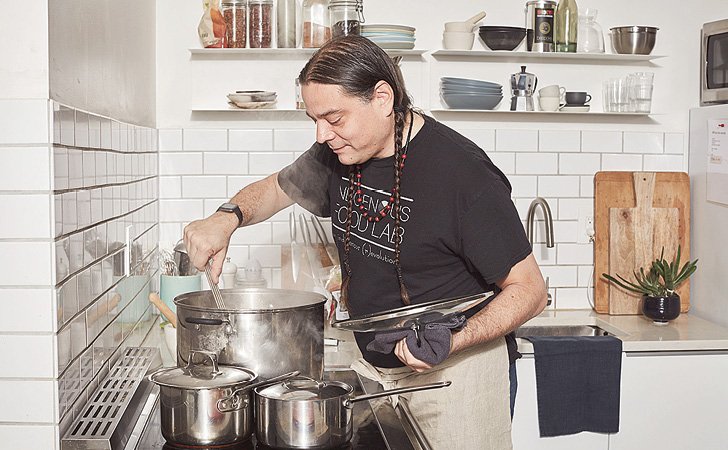The Indigenous people who populated the boreal forests of this region traveled to encampments where they would grow or gather foods based on their seasonal availability. Summer was a time for growing the three sisters (corn, squash and beans), autumn was spent harvesting wild rice and hunting, during the winters people snared animals, hunted, fished, and also utilized their stores of food. Around March came Iskigamiige-giizis in the Anishinaabe language, the maple sugar moon. Families return to the same sugar bush stands year after year, marking the end of the harsh winters and an opportunity to socialize while gathering and preparing this life-giving sweetener.
Prior to contact with European colonists, maple sugar was the primary sweetener in Indigenous cuisine. Maple sugar, it should be noted, is less refined and healthier than white sugar. According to Sean Sherman, The Sioux Chef, it has a lower glycemic content and contains important minerals such as calcium, iron and magnesium.
Sherman, who is Oglala Lakota and grew up on the Pine Ridge reservation in South Dakota, was well on his way to a successful career as a chef in the Twin Cities when he took a year off and traveled to Mexico. It was during this stay, while immersing himself in the culinary traditions of Mexico, that he saw his life’s work unfold. He recognized that many of the culinary traditions he was witnessing had survived efforts at cultural assimilation and were alive in that region. It was then that he sought to reconstruct the culinary traditions of pre-Columbian Indigenous people, traditions that had been virtually destroyed by governmental programs that included boarding schools and the delivery of commodity foods. He saw the connection between eco-systems, food and culture.
Sherman began researching pre-colonial food sources through the study of ethno-botany and by interviewing Native American elders. In his James Beard Award-winning cookbook, The Sioux Chef’s Indigenous Kitchen, he states, “I could see that long ago the tribes were sovereign over their food systems, maintaining food security through a rich knowledge of the land and its food resources.” These food resources were well managed, and the food was healthy. These studies and the development of a cuisine based on pre-Columbian food sources, has become his life’s work. This has led to the development of the non-profit, Native Traditional Indigenous Food Systems, which promotes Indigenous foodways education and facilitates Indigenous food access. Sherman states his organization provides 10,000 meals a week to nine different tribes.
I recently spoke with The Sioux Chef and asked him specifically about the use of maple as a sweetener in Indigenous cuisine. He prefaced his remarks by saying that as a boy growing up on the Pine Ridge Reservation, he did not have access to maple trees. Much of his research, though, has involved Indigenous cuisine in Minnesota, where maple sugar has long been an essential food source.

As his cuisine does not utilize any food sources not available before Columbus’ expeditions, maple, along with other tree saps such as birch and box elder, has become a primary sweetener in his recipes. Maple syrup or sugar can be substituted for sugar in recipes. Sean says maple sugar rounds the flavor of foods by opening up the flavor profile. He uses maple syrup in his teas, such as cedar tea, and in his berry sauces. He also uses it in his braising liquids—he says to add them when cooking the liquids down. Another popular recipe is his sweet potato maple soup. In general, Sherman says that maple is a staple in their kitchen.
The Sioux Chef also uses maple in his desserts. While dessert was not an integral part of Indigenous mealtimes, Sherman has developed recipes that are not overly sweet but wholesome such as sunflower cookies and autumn harvest cookies, which combine nut, wild rice or corn flour, nuts, berries and maple syrup or sugar.
Another unique use for maple that finds its way into many of Sherman’s recipes is maple vinegar. This is made from the last of the sap harvest, which contains less sugar. When set out, it naturally ferments. Sherman says he adds it to soups to give it a sour taste and is also used in food preservation. According to his book, The Sioux Chef’s Indigenous Kitchen, it is less acidic than most vinegars and “makes a terrific salad dressing and seasoning for sauces, soups, stews, and pan-fried stews—anything that needs brightening up.”
The Sioux Chef has not been idle. He has traveled the globe in his mission to educate others about the benefits of Indigenous cuisine. Through their organization, Native Traditional Indigenous Food Systems, Sherman and his partner Dana Thompson have opened Indigenous Food Lab at the Midtown Global Market in Minneapolis. This lab includes a non-profit restaurant and serves as a native foodways classroom. They also conduct research and provide food for native communities.
In May, The Sioux Chef plans to open a new restaurant in a historic building on the waterfront in Minneapolis near the Stone Arch Bridge. It will be named Owamni. The name reflects the Dakota name for the place below the St. Anthony Falls where the water swirled. The restaurant will include a park forage collaboration. According to Sherman, foraging was a big part of the Indigenous food systems. Indigenous people had a vast knowledge of the plants around them. To Sherman, food is very place-based. Plants, cultures, and the seasons influence the cuisine. In the Sioux Chef’s Indigenous kitchens, he strives to “make food taste like where we are.”
Wild Cedar and Maple Tea Recipe
Cedar is a sacred tree and, like sweetgrass and tobacco, is part of many ceremonies. It’s used to purify homes, in sweat-lodge ceremonies, and as a medicine. The tea of simmered branches is used to treat fevers and rheumatic complaints, chest colds, and flu. This brew is delicious warm or cold and is simple to make. Just simmer 2 cups of fresh cedar in 4 cups of boiling water for about 10 minutes until the water becomes a golden color. Strain off the cedar and sweeten with maple syrup, to taste.
From The Sioux Chef’s Indigenous Kitchen by Sean Sherman with Beth Dooley. Copyright 2017 Ghost Dancer, LLC. All rights reserved. Used by permission of the University of Minnesota Press.




